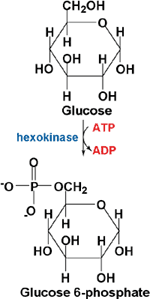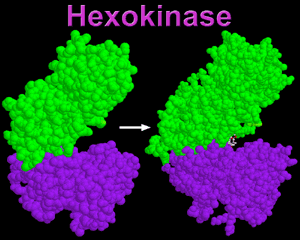|
||||||||||||
|
|
||||||||||||
Hexokinase
|
 |
|
Hexokinase catalyzes the first reaction of glycolysis, the series of reactions that metabolize intracellular glucose. Hexokinase can also break down other hexose sugars and thus has a relatively broad substrate specificity.
Kinases are a common class of enzymes in biochemistry that transfer a phosphoryl group from ATP to their respective substrates. Specifically, hexokinase enhances the nucleophilic attack of the C-6 hydroxyl group of glucose on the gamma phosphate of ATP, forming glucose-6-phosphate (G6P).
As a result of phosphorylation by hexokinase, glucose is committed to a metabolic fate, since negatively-charged G6P is unable to escape across the hydrophobic cell membrane.

As you will see, hexokinase is an obvious example of an induced fit substrate binding mechanism.
Upon binding of a hexose, a large conformational change is observed, where the enzyme clamps down on its substrate for catalysis.
Relevant Units
 |
 |
Copyright 2006, John Wiley & Sons Publishers, Inc. |
 |
 |